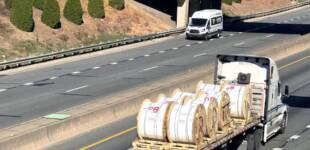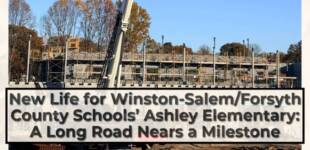‘Only You Can Prevent Wildfires’: Fire safety in Forsyth County

By Jess Schnur
Since Thursday, March 20, the North Carolina Forest Service has issued a state-wide burn ban amidst a rise in wildfires across the Carolinas. “It is spring wildfire season in North Carolina, and we are seeing wildfire activity increase due to dry conditions,” said Agriculture Commissioner Steve Troxler during the issuing of the ban last week. “With these ongoing conditions, a statewide burn ban is necessary to reduce the risk of wildfires starting and spreading quickly. Our top priority is always to protect lives, property and forestland across the state. It is imperative that folks adhere to this burn ban until further notice.”
Across all 100 counties of North Carolina, all forms of open burning are now strictly prohibited regardless of permit status. New permits regarding open burning will not be issued until after the ban has ceased. Those who violate the ban face a $100 fine plus $183 court costs. The ban does not apply to fires started within 100 feet of an occupied dwelling, though fire marshalls have jurisdiction to incur a ban within these parameters, if necessary, in certain localities. Local fire departments and law enforcement officers will be assisting the North Carolina Forest Service in enforcing the ban until further notice.
“My grandmother always said March came in like a lion and went out like a lamb,” said Fire Chief Trey Mayo of the Winston-Salem Fire Department (WSFD) in an interview with The Chronicle. “It’s typically a windy month. We have been without substantial rain across the state for a period of weeks and the relative humidity has been low for probably the last week or 10 days. I looked this morning, I think the relative humidity for Forsyth County was 19%, which is really low. So, what you get is … grasses along the roadside, debris that’s on the forest floor, you know, landscaping materials, those sorts of things get really, really dry. The atmosphere is really dry and the wind is blowing.”
Many of the fires are concentrated in the western part of North Carolina due to its treacherous terrain in the steep seclusion of the mountains. The areas that had been previously afflicted by Hurricane Helene this past October are among those getting hit the hardest. “There is a lot of fuel on the ground in that part of the state from all the trees that blew down following when the remnants of Hurricane Helene moved up through western North Carolina,” explained Chief Mayo. “So, they’ve got all that fuel on the ground. And, of course, having all those trees and things on the ground make access and moving around when you do it, when you can get firefighting resources in, it’s just all the more difficult for them to move around when they can get in somewhere.”
According to Chief Mayo, 80% of fires and fire deaths in America occur in a residential setting. Many factors including landscaping materials (especially the use of pine straw as mulch), construction of houses using flammable siding (such as vinyl or wood over brick and cement), and lack of accessibility in entryways and yards (such as long winding driveways, unclearly marked addresses, or bridges and pavements that can’t support the weight of emergency vehicles) for fire trucks to arrive on the scene are cited by Chief Mayo as to what makes these residentiary fires so dangerous, and are important considerations for residents when thinking of renovations.
But the first step to fire safety is always prevention: “I can’t stress enough the [importance of] properly discarding your smoking materials,” said Chief Mayo. “The fireplace ashes, you know, dumping out a charcoal grill, fireworks, any of those things can serve as a source of ignition when conditions are like they are today and have been for the past, like I say, week or ten days.”
But these fires are not limited to being strictly residential; all areas of dry vegetation coupled with these weather conditions serve as fuel for wildfires. One of the prime locations for these fires lies along the local roads and highways. “We will be chasing grass fires along the median,” Chief Mayo said. “I-40, 52, 421 and at intersections all over town where, you know, folks are sitting at a red light or whatever and thump a cigarette butt out the window and it sets the median on fire. … It’s not uncommon on a day like this for us to chase down eight or 10 or 12 of those.”
Fortunately for Forsyth County, these fires are easier for local emergency services to respond to due to the terrain. “Forsyth County is one of the smallest counties in the state, so that’s playing in our favor,” said Chief Mayo. “We’re in the foothills, but the terrain here is not mountainous. And we don’t have these just huge tracks that are tens of thousands of acres or thousands of square miles of undeveloped area that we can’t get into.”
But this does not mean that the threat of fire is not to be taken lightly. Just last Saturday, March 22, a brush fire had set ablaze on West Hanes Mill Road just before 5 p.m. Though the fire had been quickly extinguished by the WSFD, it serves as a reminder that it is everyone’s responsibility to take precautions to prevent these fires from their initial ignition.










